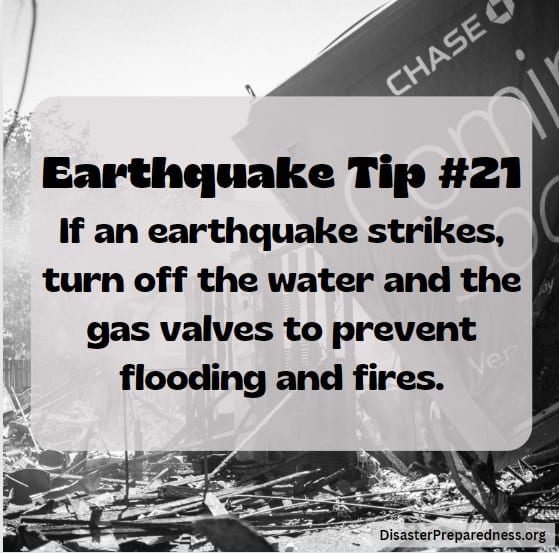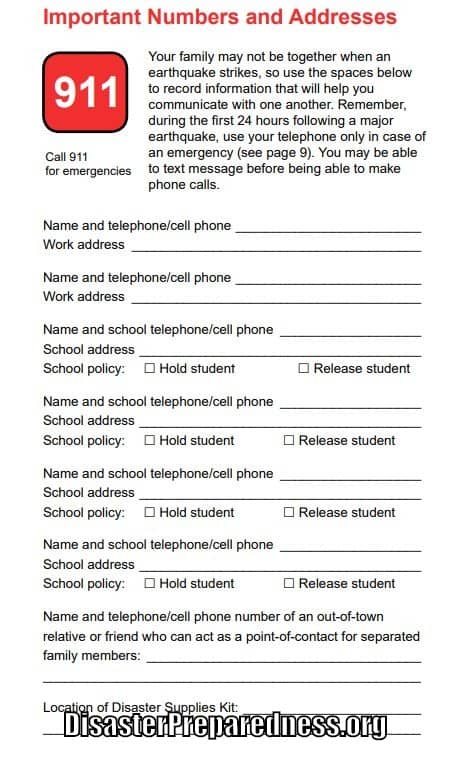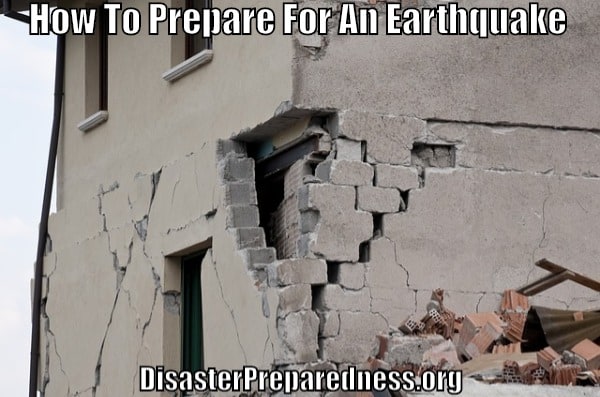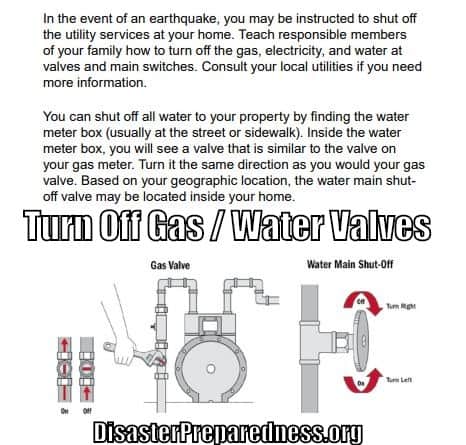Disaster Preparedness: Preparing Your Home For An Earthquake
Earthquake Safety at Home
First things first… your home needs to be prepared BEFORE the earthquake. Please invest your time into the safety of your family and home.
You never know when an earthquake will strike. If you live in an area at risk for earthquakes, there are you can take to minimize risk for your family and home.
First, get together your contact information – note the most important item might be, “Name and telephone/cell phone number of an out-of-town relative or friend who can act as a point-of-contact for separated family members.”
Earthquake Preparation Involves:
-
- How to prepare your family for an earthquake (understanding what you should do before, during, and after earthquakes)
- How to prepare your home for an earthquake
- Preparing now, before the next quake
- Keep a pair of old shoes under your bed so you don’t have to walk on broken glass.
- When power goes out it will be hard to access an ATM or a gas station. Have cash, in small denominations, kept near your earthquake kit and keep your gas tank full.
- Keep a Solar Cell Phone Charger – Solar powered charges start in the mid $20 range and go up from there. The best selling Amazon solar charger is $60 and is fast with “Industrial-strength PET polymer faced solar panels sewn into a rugged polyester canvas offer weather-resistant outdoor durability.”
- Crank Powered Radio – You can pay upwards of $100 for a decent unit. The best selling Amazon crank radio is just $20.)
- Emergency Water Filter– No need for a super fancy system. The LifeStraw Personal Water Filter has 5,000 reviews and is $20.
How To Prepare Your Home For An Earthquake
There are two main areas to consider when preparing your home – the physical structure and safety of your home and the contents of your home.
Physical Structure, Foundation – A rough rule of thumb is that the older the home, the more likely you are to have damage. Homes built in the last 20 years tend to have been constructed with more rigorous building codes (depending on your city and state). If you are building or buying a home, make sure that it complies with the seismic provisions of your local building code. Older homes sometimes are not anchored to their foundations or having weak crawl space walls, unbraced pier-and-post foundations, or unreinforced masonry walls or foundations. Brick buildings are exceptionally susceptible to earthquake shaking.
Interior Contents Considerations – When the ground shakes your home vigorously expect anything not anchored to the wall to potentially become dangerous. Examples are a TV that can fall off a stand, an unsecured cabinet, a bookcase or chest of drawers that can tip over. Even a frig can become lethal during the most violent earthquake. Perform an assessment of each room of your home and identify tall, heavy, or expensive objects such as bookcases, home electronics, appliances, water heater (use a hot water tank earthquake strap for about $25), and items hanging from walls or ceilings. Secure these items with flexible fasteners, such as nylon earthquake straps (about $20), earthquake putty (about $5 to hold artwork) or with earthquake cables (about $5 each). At a minimum, relocate items that can fall away from your bed. You can also use a cabinet latch to make sure dishes and kitchenware don’t fall out. Ensure that plumbers have installed flexible connectors on all gas appliances.
This furniture safety strap set is made of heavy-duty metal cleats, wall brackets, and fasteners, as well as triple-stitched nylon webbing, and can support up to 400 lbs. These wall straps do not have any weak links in the form of plastic components or glue, making them reliable for anchoring furniture.
This product is ideal for securing antiques, collectibles, and other fragile items from falling. It works on almost any surface and is easy to apply due to its pliable texture.
These secure straps can be easily adjusted up to 21 inches long to hold bookcases, dressers, and other large furniture items upright. For added safety, use two straps for each item and three for taller or heavier furniture pieces.
- Homebuilders’ Guide to Earthquake Resistant Design and Construction (FEMA 232): A FEMA guide about strengthening new and existing homes.
- Reducing the Risks of Nonstructural Earthquake Damage—A Practical Guide, Fourth Edition (FEMA E-74): An additional guide on how to secure the contents of your home.
How To Prepare Yourself and Your Family For An Earthquake
Four Earthquake Safety Items To Purchase – Have these critical necessities (all the below are Amazon’s top 5* rated items):
-
- First Aid Kits – For $20 you can have medical supply basics, all in one place, ready to – it is worth it for you and your family.
- Solar Cell Phone Charger – Solar powered charges start in the mid $20 range and go up from there. The best selling Amazon solar charger is $60 and is fast with ‘Industrial-strength PET polymer faced solar panels sewn into a rugged polyester canvas offer weather-resistant outdoor durability.’ Both are presented below.
- Crank Powered Radio – You can pay upwards of $100 for a decent unit. The best selling Amazon crank radio is just $20.
- Emergency Water Filter – No need for a super fancy system. The LifeStraw Personal Water Filter has 5,000 reviews and is $20.
The Lifestraw Water Filter is highly effective in removing harmful bacteria and parasites from water. Its microfiltration membrane eliminates 99.99% of waterborne bacteria, such as E. Coli and Salmonella, as well as 99.99% of waterborne parasites like Giardia and Cryptosporidium.
This weather radio is equipped with 5 different power sources, making it the ideal choice during prolonged power outages. The hand crank, solar panel, and AC power options make it easy to keep the radio running.
This power bank has a large cell capacity of 36800mAh, which is made possible by the use of industry-leading high-density lithium polymer cells. It is compact and has a high-quality, high-density battery that can support thousands of charge cycles.
Be sure to share this page with family members and friends!
How To React Safely To An Earthquake – Learn what to do during an earthquake. Hold periodic family drills to practice what you have learned. Through practice, you can condition yourself and family to react spontaneously and safely when the first jolt or shaking is felt.
How To Take Cover During An Earthquake – In each room of your home, identify the safest places to “drop, cover, and hold on” during an earthquake. Practice going to these safe spots during family drills to ensure that everyone learns where they are.
Preparing To Survive on Your Own After An Earthquake – Assemble and maintain a household emergency supply kit, and be sure that all family members know where it is stored. The kit should consist of one or two portable containers (e.g., plastic tubs, backpacks, duffel bags) holding the supplies that your family would need to survive without outside assistance for at least 3 days following an earthquake or another disaster. Make additional, smaller kits to keep in your car(s) and at your place(s) of work.
Have A Family And Friends Contact List – List addresses, telephone numbers, and evacuation sites for all places frequented by family members (e.g., home, workplaces, schools). Include the phone number of an out-of-state contact. Ensure that family members carry a copy of this list, and include copies in your emergency supply kits.
Care for People, Pets, and Property – Get training in first aid and cardiopulmonary resuscitation (CPR) through your local chapter of the American Red Cross. Find out where you could shelter your pet should it become necessary to evacuate your home. Ensure that family members know how and when to call 9-1-1, how to use your home fire extinguisher, and how, where, and when to shut off your home’s utilities (water, natural gas, and electricity). Ask your state insurance commissioner about the availability of earthquake insurance in your state.
FEMA documents on preparing yourself and your family:
- Are You Ready? An In-depth Guide to Citizen Preparedness (IS-22)
- Earthquake Safety Checklist (FEMA 526)
After An Earthquake
 When the shaking stops, look around. If there is a clear path to safety, leave the building and go to an open space away from damaged areas.
When the shaking stops, look around. If there is a clear path to safety, leave the building and go to an open space away from damaged areas.- Check for Injuries. If anyone has stopped breathing, follow the American Heart Association’s guidelines on CPR.
- Stop any bleeding injury by applying direct pressure to the wound. Do not move seriously injured people unless they are in immediate danger of further injury. Cover injured persons with blankets to keep them If you are trapped, do not move about or kick up dust.
- If you have a cell phone with you, use it to call or text for help.
- Tap on a pipe or wall or use a whistle, if you have one, so that rescuers can locate you.
- Check to see that water and sewage lines are intact before using the toilet. Plug bathtub and sink drains to prevent sewage backup.
- Once safe, monitor local news reports via battery-operated radio, TV, social media, and cell phone text alerts for emergency information and instructions.
- Be prepared to “Drop, Cover, and Hold on” in the likely event of aftershocks.
- Be sure to turn off any gas or water valves for safety (keep a spare wrench tied to the gas valve)
Once the shaking stops, check for injuries among your family and neighbors and, as needed, administer first aid and call for emergency medical assistance. Note that emergency services will probably be overwhelmed and won’t be able to assist with non-life-threatening injuries right away. Also, check for hazards in and around your home created by earthquake damage. Keep in mind that aftershocks may strike at any time, exacerbating these hazards and requiring you to immediately drop, cover, and hold on.
Could it get worse? Well, yes. Be aware of possible tsunamis if you live in a coastal area. Tsunamis are also known as seismic sea waves. When local authorities issue a tsunami warning,
assume that a series of dangerous waves is on the way. Move inland to higher ground as quickly as possible. Read about the Cascadia Fault near the Pacific Northwest.
- Earthquake Safety Checklist (FEMA 526) – FEMA guidance on what to do once the shaking stops.
- USGS Earthquake Map – The has a real-time earthquake map so you can see the location and strength of any earthquake worldwide.










